Every day, enterprises invest in AI agents hoping to accelerate critical business outcomes, optimize workflows, and enhance customer experiences. Yet too often, these initiatives fall short. Teams struggle to adopt AI effectively, insights remain fragmented, and expected results fail to materialize.
The missing piece? The AI agent framework, the architecture that turns potential into performance. Frameworks determine how agents understand complex processes, collaborate across teams, and scale impact enterprise-wide. Without the right framework, even the most advanced AI agents can remain underutilized and disconnected from measurable business outcomes.
Choosing the right AI agent framework is a strategic decision with tangible consequences. The right framework transforms AI from a set of tools into an intelligence engine that unifies operations, generates actionable insights, and drives growth. Organizations with strong AI foundations achieve 20–30% faster time-to-market (McKinsey), while Gartner predicts that by 2026, over 70% of enterprises will rely on frameworks to coordinate automation and guide enterprise-wide strategic decisions.
With orchestration-based, conversational, platform-driven, and data-centric frameworks available, the landscape is complex. This blog helps you evaluate framework types, understand their trade-offs, and select the right fit, ensuring your AI initiatives deliver measurable outcomes and unlock the full potential of different types of AI agents across your enterprise.
Understanding AI agent framework
An AI agent framework is a structured platform that enables organizations to create, deploy, and manage AI agents efficiently and at scale. It defines the architecture, rules, interfaces, algorithms, and operational guidelines that govern agent behavior, ensuring reliability, consistency, and seamless integration with enterprise systems. It also determines how AI agents process data, execute workflows, and interact with human processes, enabling them to generate actionable insights and deliver measurable business outcomes aligned with strategic objectives.
The purpose of an AI agent framework is to simplify development, ensure interoperability, and accelerate business impact. It serves as the essential foundation for building and running AI agents. By providing standardized workflows, prebuilt components, and integration capabilities, frameworks reduce complexity, shorten implementation time, and maintain consistent performance across teams and processes.
Within enterprise ecosystems, AI agent frameworks connect AI agents to workflows, data sources, and operational systems. This ensures agents operate contextually, support business objectives, and transform AI initiatives from isolated experiments into scalable solutions that drive efficiency, insight, and measurable results.
Selecting the right AI agent framework is a strategic decision. The right framework ensures scalability, adaptability, and seamless integration, enabling organizations to maximize AI effectiveness and achieve sustainable business value.
Key components of AI agent frameworks
AI agent frameworks are composed of distinct layers that collectively enable AI agents to operate effectively within an enterprise. Understanding these layers is critical to leveraging AI agents for scalable, reliable, and measurable business outcomes.
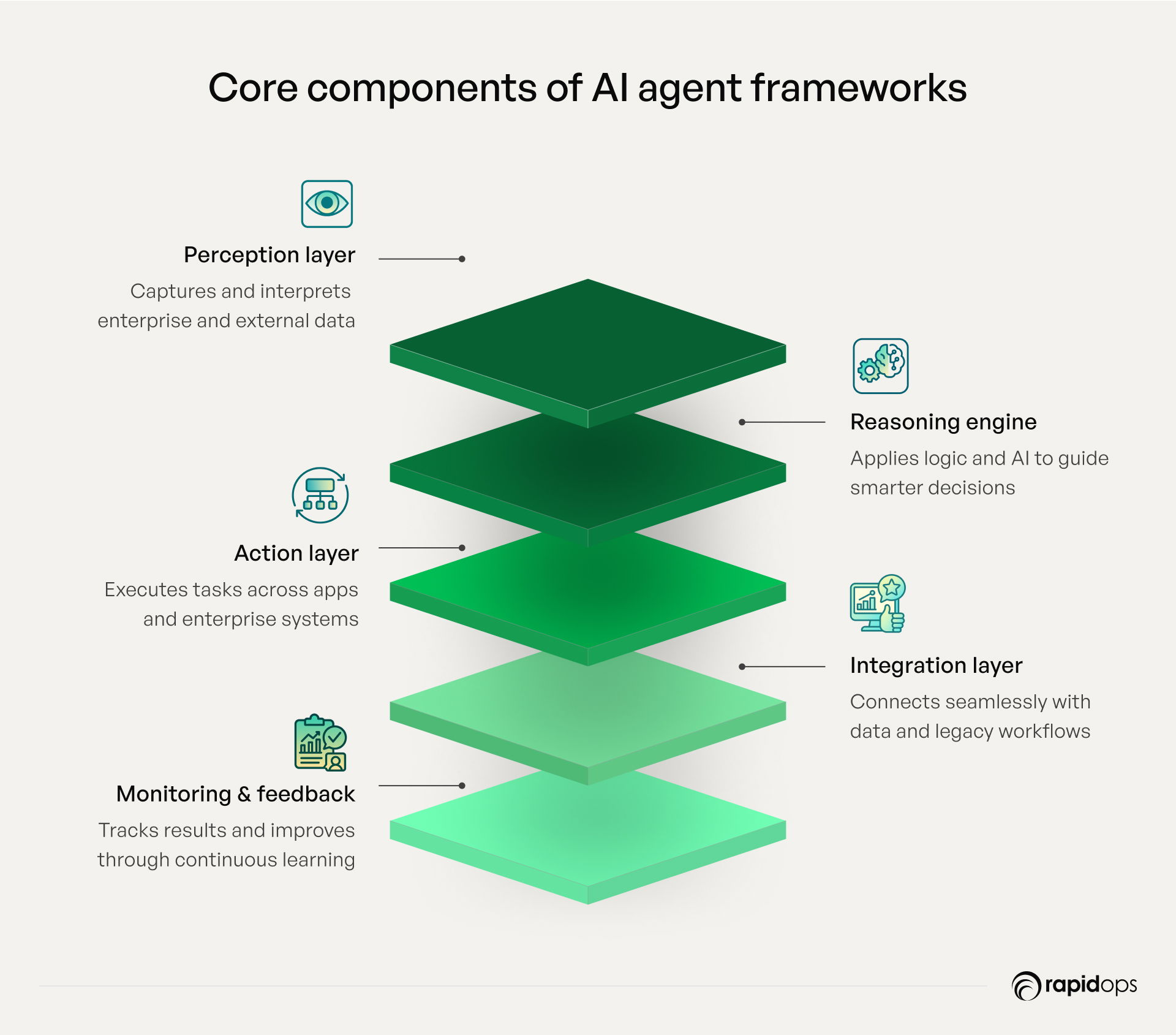
1. Perception layer
This layer captures and interprets data from internal systems, APIs, and external sources. By providing context and situational awareness, it allows AI agents to understand the environment, identify relevant inputs, and process information accurately for informed action.
2. Reasoning & decision engine
The reasoning layer applies logic, business rules, and AI models to analyze data and determine optimal courses of action. It empowers agents to make data-driven, contextually aware decisions, bridging AI intelligence with enterprise strategy.
3. Action/execution layer
Once decisions are made, the action layer executes them by interacting with software applications, APIs, or automation tools. This ensures that insights translate into concrete operational outcomes efficiently and reliably.
4. Integration layer
The integration layer connects AI agents seamlessly with enterprise workflows, systems, and data pipelines. It ensures interoperability across departments and platforms, allowing AI initiatives to function as enterprise-wide solutions rather than isolated experiments.
5. Monitoring & feedback layer
This layer tracks agent performance, outcome accuracy, and operational impact. It supports continuous learning and optimization, enabling AI agents to adapt over time, improve decision quality, and maintain alignment with evolving business objectives. Together, these layers form a comprehensive architecture that allows AI agents to perceive, reason, act, integrate, and improve, ensuring that enterprise AI initiatives are scalable, intelligent, and strategically aligned.
What are the different types of agent frameworks
Before selecting an AI agent framework, evaluate how each type will influence your enterprise’s operations, integration, and insight generation. Understanding these distinctions equips leaders to align frameworks with business objectives, optimize workflows, and unlock measurable strategic value.
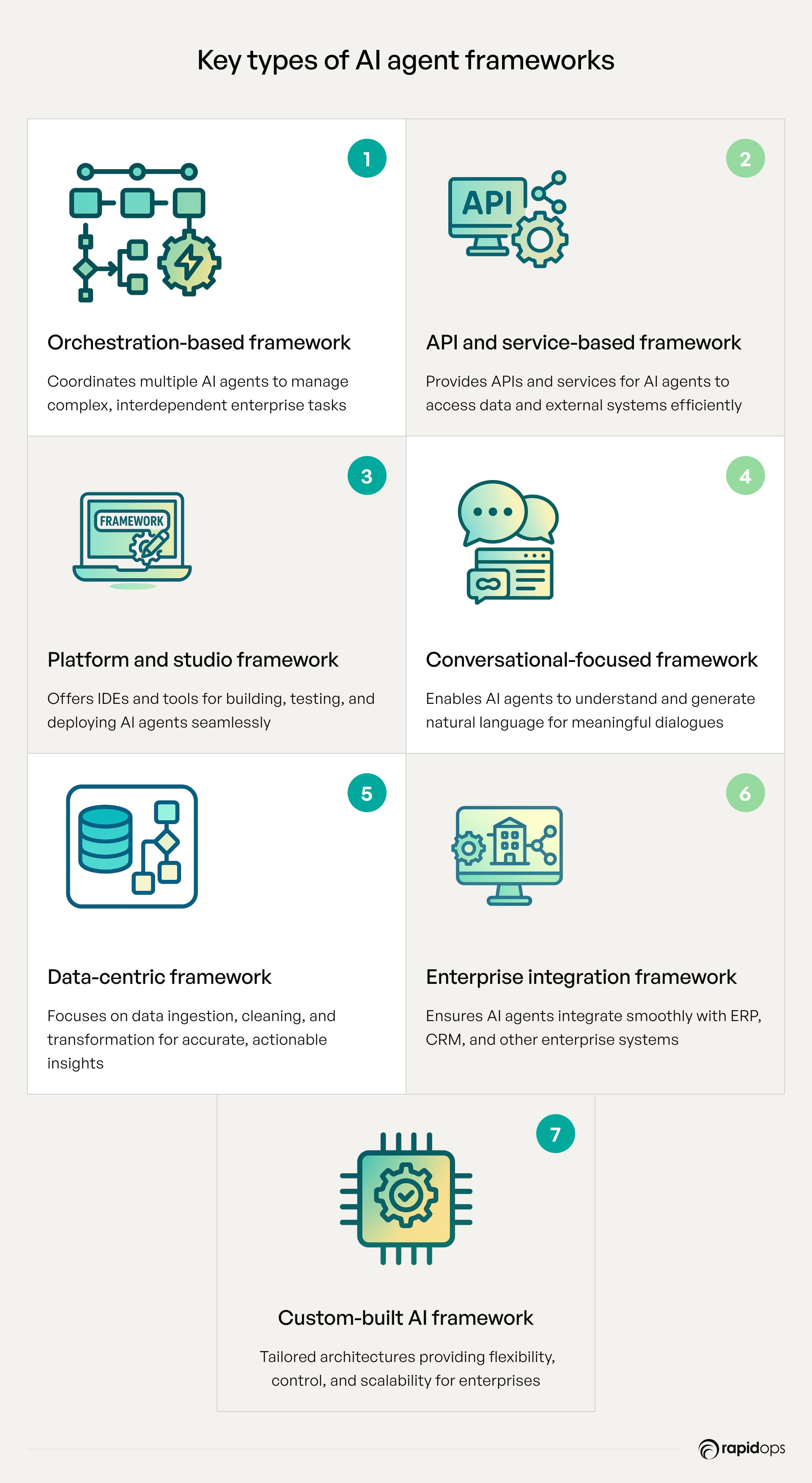
1. Orchestration-based frameworks
Orchestration-based frameworks provide a centralized control layer that coordinates the activities of multi-agent AI, ensuring they work in harmony to achieve complex objectives. These frameworks are particularly useful in scenarios requiring the management of interdependent tasks across various systems.
Examples
- Accedo Compose: Utilizes modular AI agents to monitor user behavior and autonomously optimize viewer touchpoints in streaming services.
- Microsoft Semantic Kernel: Offers a powerful orchestration layer for AI agents, facilitating the integration of various AI models and services within enterprise applications.
2. API/service-based frameworks
API/service-based frameworks focus on providing robust APIs and services that enable AI agents to interact with external systems and data sources. These frameworks are essential for building agents that require real-time data access and interaction with third-party services.
Examples
- LangChain: Provides tools for building agents with memory stores, API connectors, and workflow orchestration.
- AutoGen: Enables multi-agent systems with customizable agent roles and shared memory for coordination.
3. Platform/studio frameworks
Platform/studio frameworks offer integrated development environments (IDEs) that simplify the creation and management of AI agents. These platforms often include drag-and-drop interfaces, pre-built templates, and tools for testing and deploying agents.
Examples
- IBM Watson Studio: Provides a suite of tools for building, training, and deploying AI models and agents.
- Google Cloud AI platform: Offers a comprehensive set of tools for developing AI applications, including agent-based systems.
4. Conversational-focused frameworks
Conversational-focused frameworks are designed to build AI agents that specialize in natural language understanding and generation, enabling them to engage in meaningful dialogues with users.
Examples
- Botpress: An open-source conversational AI platform that allows developers to create and manage chatbots and virtual assistants.
- Dialogflow: A Google Cloud service that enables the development of conversational interfaces for applications.
5. Data-centric frameworks
Data-centric frameworks emphasize the importance of data management and processing in the development of AI agents. These frameworks provide tools for data ingestion, cleaning, and transformation, ensuring that agents have access to high-quality data for decision-making.
Examples
- Apache Kafka: A distributed event streaming platform used to build real-time data pipelines and streaming applications.
- Apache NiFi: A data integration tool that automates the movement and transformation of data between systems.
6. Enterprise integration frameworks
Enterprise integration frameworks focus on ensuring that AI agents can seamlessly integrate with existing enterprise systems, such as customer relationship management (CRM) and enterprise resource planning (ERP) systems.
Examples
- SAP AI Core: Integrates AI capabilities into SAP's enterprise applications, enabling intelligent automation and decision-making.
- Oracle AI Platform: Provides tools for embedding AI into Oracle's suite of enterprise applications.
7. Custom-built AI agent frameworks
Custom-built frameworks offer organizations the flexibility to design AI agent architectures tailored to their specific needs and requirements. These frameworks allow for the integration of proprietary models, data sources, and workflows, providing complete control over the agent's behavior and capabilities.
Benefits
- Flexibility: Tailor the framework to specific business processes and requirements.
- Control: Full oversight over the agent's decision-making processes and data usage.
- Scalability: Design the framework to scale according to organizational growth and complexity.
Considerations
- Resource intensive: Requires significant investment in development and maintenance.
- Complexity: Demands expertise in AI, software engineering, and system integration.
Example
In-house developed frameworks: Many large enterprises develop their own AI agent frameworks to meet unique business needs, such as personalized customer service or complex supply chain optimization. With a clear understanding of each framework’s capabilities and trade-offs, enterprises can implement AI agents that integrate seamlessly, scale efficiently, and drive actionable intelligence, transforming AI initiatives into sustainable, enterprise-wide advantage.
How AI agent frameworks make building agents easier
Building AI agents is inherently complex, and even in cases where parts of a framework already exist within your systems, a robust AI agent framework is essential, it serves as the foundation on which agents are designed, integrated, and scaled. Frameworks provide structured workflows, pre-built tools, and best practices, enabling enterprises to develop intelligent agents efficiently, ensure smooth operations, and achieve measurable business outcomes.
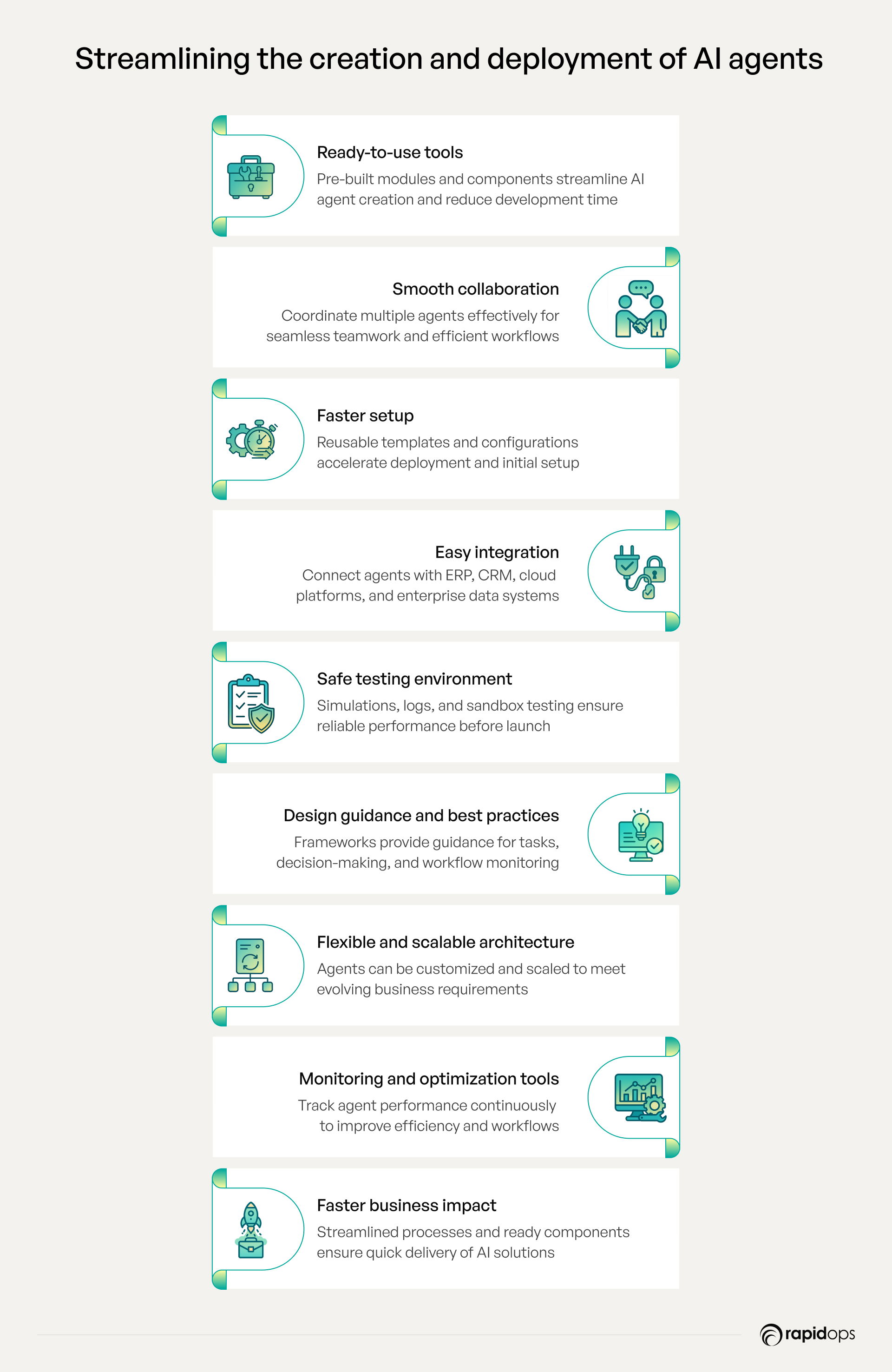
1. Ready-to-use modules
Frameworks include pre-built components, connectors, and templates, allowing teams to assemble agents quickly without building them from scratch. This not only accelerates development but also ensures consistent functionality and reduces errors across multiple deployments.
2. Centralized orchestration
By enabling smooth management of multiple agents, frameworks facilitate coordination across teams and departments. This centralized control ensures that agents work harmoniously, adhere to enterprise standards, and execute complex workflows efficiently.
3. Rapid deployment
Reusable templates and structured processes streamline setup and implementation. Enterprises can bring AI agents online faster, reducing time-to-value while maintaining quality and compliance.
4. Seamless integration
AI agent frameworks connect agents to ERP, CRM, cloud platforms, and data pipelines, enabling contextual and efficient operations. This integration allows agents to act on live data, interact with existing systems, and provide actionable insights.
5. Reliable validation
Built-in simulation environments, detailed logging, and testing capabilities allow enterprises to validate agent behavior before deployment. This ensures agents perform reliably in production, minimizing operational risks and service disruptions.
6. Guided agent design
Frameworks provide best-practice guidance on task execution, decision-making, and monitoring. Teams can design purpose-driven agents that align with business objectives and deliver measurable outcomes consistently.
7. Flexibility and scalability
Agents can be customized to specific business needs and scaled across processes, teams, or geographies. Frameworks support modular and adaptive design, enabling enterprises to evolve AI capabilities without reengineering the system.
8. Continuous monitoring and optimization
Frameworks provide real-time performance tracking, feedback loops, and analytics. Enterprises can iteratively improve agent efficiency, accuracy, and relevance, ensuring long-term value and adaptability in dynamic business environments.
9. Accelerated business impact
By streamlining development, integration, and optimization, AI agent frameworks allow enterprises to achieve faster operational improvements, actionable insights, and measurable results, transforming AI initiatives into strategic assets.
Key factors in choosing the right AI agent framework
Even advanced AI agents underperform if frameworks fail to align with enterprise goals. Prioritizing performance, scalability, integration, flexibility, and vendor ecosystem empowers leaders to select frameworks that streamline operations, enhance reliability, and deliver measurable, long-term business impact.

1. Task capability & extensibility
The first question is: Can this framework perform the sophisticated tasks you want to automate? If not, can it be customized to do so? Frameworks vary in strengths and limitations, so assessing this upfront ensures AI agents meet your operational goals. Early evaluation prevents misalignment, ensuring the platform supports advanced decision-making, workflow automation, and predictive analytics, ultimately delivering measurable outcomes and long-term business value.
2. Business alignment
A framework must align with your enterprise goals, strategic priorities, and long-term value creation. Well-aligned frameworks ensure AI agents directly contribute to tangible outcomes, optimizing customer engagement, accelerating operations, or enhancing decision-making processes. For instance, integration with CRM systems enables personalized customer interactions while maintaining operational efficiency.
3. Ease of development
Frameworks with pre-built components, SDKs, templates, and best-practice guidance reduce complexity and accelerate deployment. Simplified development allows teams to focus on innovation rather than reinventing the wheel. Reusable agent templates and streamlined testing further speed implementation across departments.
4. Scalability
Choose frameworks that can grow with your enterprise, handling increasing workloads without compromising performance. Scalable platforms enable seamless expansion of AI agent coverage across teams, geographies, or processes, ensuring sustained business impact over time.
5. Integration capabilities
Frameworks must connect effortlessly with ERP, CRM, cloud platforms, and other enterprise systems. Seamless integration ensures agents act on real-time data, automate workflows, and generate actionable insights without creating silos. For example, linking agents to supply chain or inventory systems can automate stock management, reduce operational delays, and increase responsiveness.
6. Flexibility & customizability
Your agents should adapt to specific workflows, tasks, and industry requirements. Frameworks that allow tailoring agent behaviors and decision-making logic ensure solutions meet enterprise needs precisely, rather than enforcing a one-size-fits-all approach.
7. Multi-agent orchestration
For complex operations, multiple agents must coordinate efficiently. Frameworks with centralized orchestration enable agents to work harmoniously, execute interdependent tasks reliably, and deliver consistent results across enterprise processes.
8. Performance & reliability
The framework should guarantee consistent outcomes under varying workloads and conditions. Reliable platforms reduce errors, minimize downtime, and ensure agents perform predictably in production environments, safeguarding business continuity.
9. Monitoring & analytics
Real-time tracking of agent performance, behavior, and optimization opportunities is crucial. Analytics help refine agent decision-making, workflows, and alignment with business goals, ensuring continuous value delivery.
10. Vendor support & ecosystem
Strong vendor support, active communities, and comprehensive documentation accelerate adoption, troubleshoot challenges, and provide ongoing updates. Frameworks backed by robust ecosystems allow enterprises to leverage pre-built integrations, community innovations, and expert guidance.
11. Cost & total value
Framework selection should balance upfront investment with long-term operational and innovation benefits. Evaluating total cost of ownership including maintenance, scalability, and potential productivity gains, ensures the framework delivers measurable ROI. By assessing AI agent frameworks on these factors, you can choose a platform that aligns with your goals, scales with your operations, and turns AI initiatives into measurable, enterprise-wide business impact.
Comparing AI agent frameworks: Open-source, enterprise-ready and custom-built
Every enterprise has unique objectives for AI agents, from automating processes to generating actionable insights. Evaluating open-source, enterprise-ready, and custom-built frameworks ensures leaders select platforms that balance flexibility, integration, and compliance, turning AI initiatives into scalable, high-impact solutions.
Open-source frameworks
Open-source AI agent frameworks offer high flexibility, community-driven innovation, and full access to underlying code, making them ideal for rapid experimentation and prototyping. Organizations can modify modules, test new AI models, and customize workflows to unique operational needs. However, leveraging open source effectively requires skilled internal teams to maintain, secure, and scale solutions. While cost-efficient initially, enterprises must plan for ongoing development and compliance oversight to ensure consistent performance and reliability in production environments.
Enterprise-ready (Off-the-Shelf) frameworks
Enterprise-ready frameworks provide fully supported platforms with pre-built modules, enterprise integrations, and vendor service-level agreements. They simplify deployment at scale, ensure regulatory compliance, and reduce operational risk by delivering predictable performance. These frameworks accelerate adoption and minimize technical debt, allowing enterprises to focus on strategic applications rather than maintenance. The trade-off is lower flexibility and higher upfront or subscription costs, yet they provide stability, faster time-to-value, and operational reliability critical for large-scale AI initiatives.
Custom-built frameworks
Custom-built frameworks are designed specifically for your enterprise’s unique workflows, data pipelines, and business goals, offering unmatched control and strategic alignment. They allow you to tackle complex operational challenges, integrate proprietary AI models, and optimize performance across diverse use cases.
While building a custom framework requires deep AI and software expertise, it delivers the highest long-term value, evolving with your business needs, unlocking advanced automation, and transforming AI initiatives into enterprise-wide capabilities. For organizations seeking maximum strategic impact, operational agility, and measurable outcomes, a custom-built framework becomes more than a platform, it’s a foundation for sustainable competitive advantage.
Key differences and use cases at a glance
After exploring the top AI agent frameworks, here’s a side-by-side comparison highlighting their key features, advantages, and considerations. This table helps enterprises quickly assess which framework aligns with their operational goals and strategic priorities.
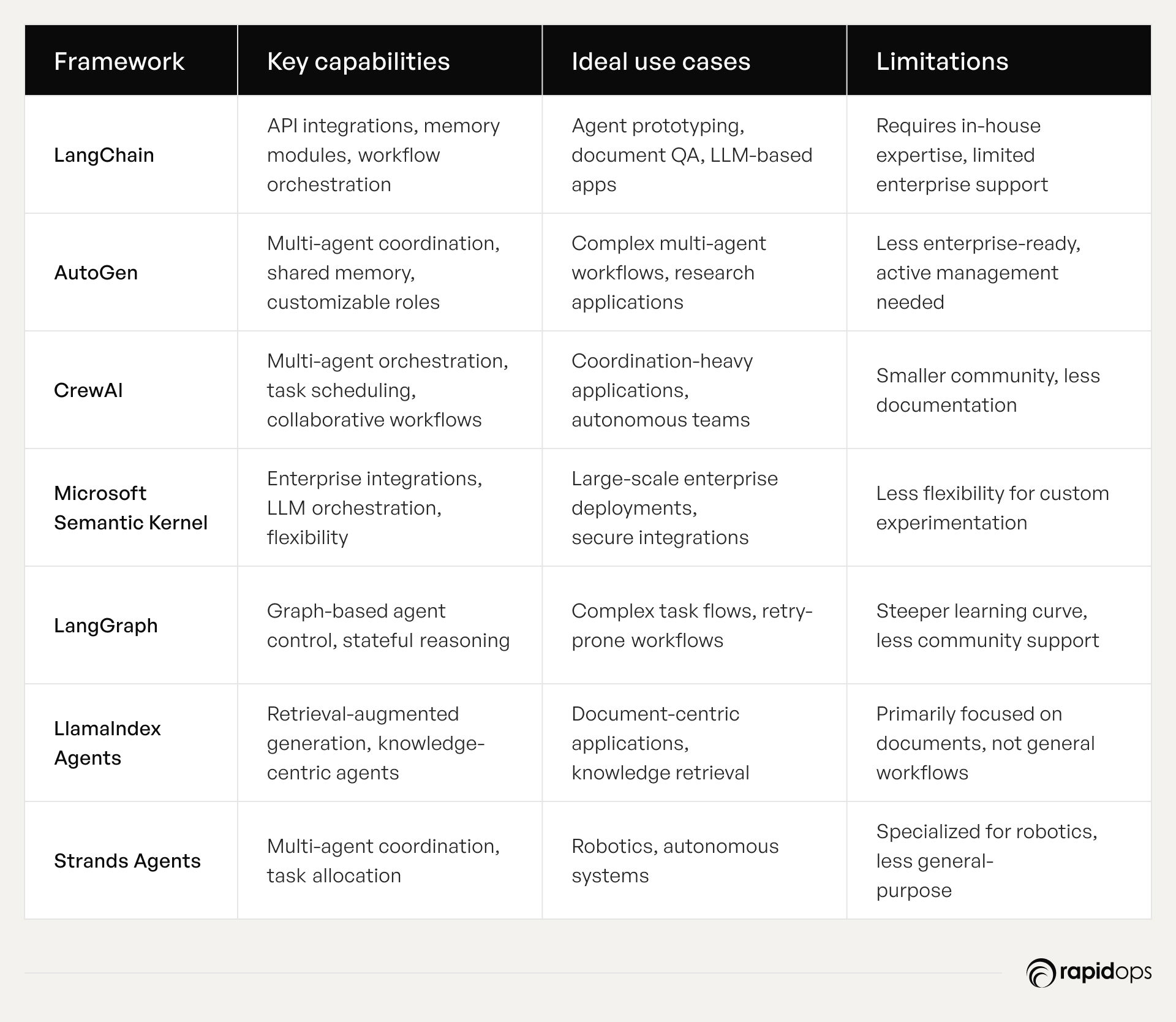
Aligning framework choice with enterprise priorities
Enterprises face diverse operational and strategic challenges, and AI agent frameworks must align closely with these priorities to deliver meaningful impact. Proper alignment ensures that AI initiatives are not just technically viable but also operationally effective, scalable, and strategically valuable.
By industry:
Retail
Frameworks enable personalized customer engagement, AI-based demand forecasting, and inventory optimization, helping retailers anticipate trends, reduce waste, and enhance customer loyalty.
Manufacturing
Intelligent automation, predictive maintenance, and supply chain optimization are accelerated by frameworks that integrate AI agents seamlessly into complex production environments.
Distribution
Dynamic route optimization, real-time coordination, and logistics automation allow distribution networks to respond quickly to changing conditions, reducing costs and improving service reliability.
By business objective:
Operational efficiency
Frameworks streamline workflows, automate repetitive tasks, and enhance decision-making, enabling teams to focus on strategic initiatives rather than manual processes.
Revenue growth
AI agents powered by well-aligned frameworks support demand prediction, personalized marketing, and customer experience improvements, directly contributing to measurable business expansion.
Risk management
Frameworks help monitor operational, compliance, and market risks in real time, enabling proactive mitigation and reinforcing organizational resilience.
When frameworks are thoughtfully aligned with both industry-specific needs and broader business objectives, enterprises transform AI agent initiatives from isolated experiments into enterprise-wide capabilities that drive efficiency, insights, and sustainable competitive advantage
Implementation considerations and best practices
Successfully implementing AI agent frameworks requires more than technology deployment, it demands a strategic approach that integrates experimentation, adoption, governance, and continuous optimization. Enterprises that follow structured best practices can translate AI capabilities into measurable business outcomes while minimizing risks and maximizing organizational readiness.
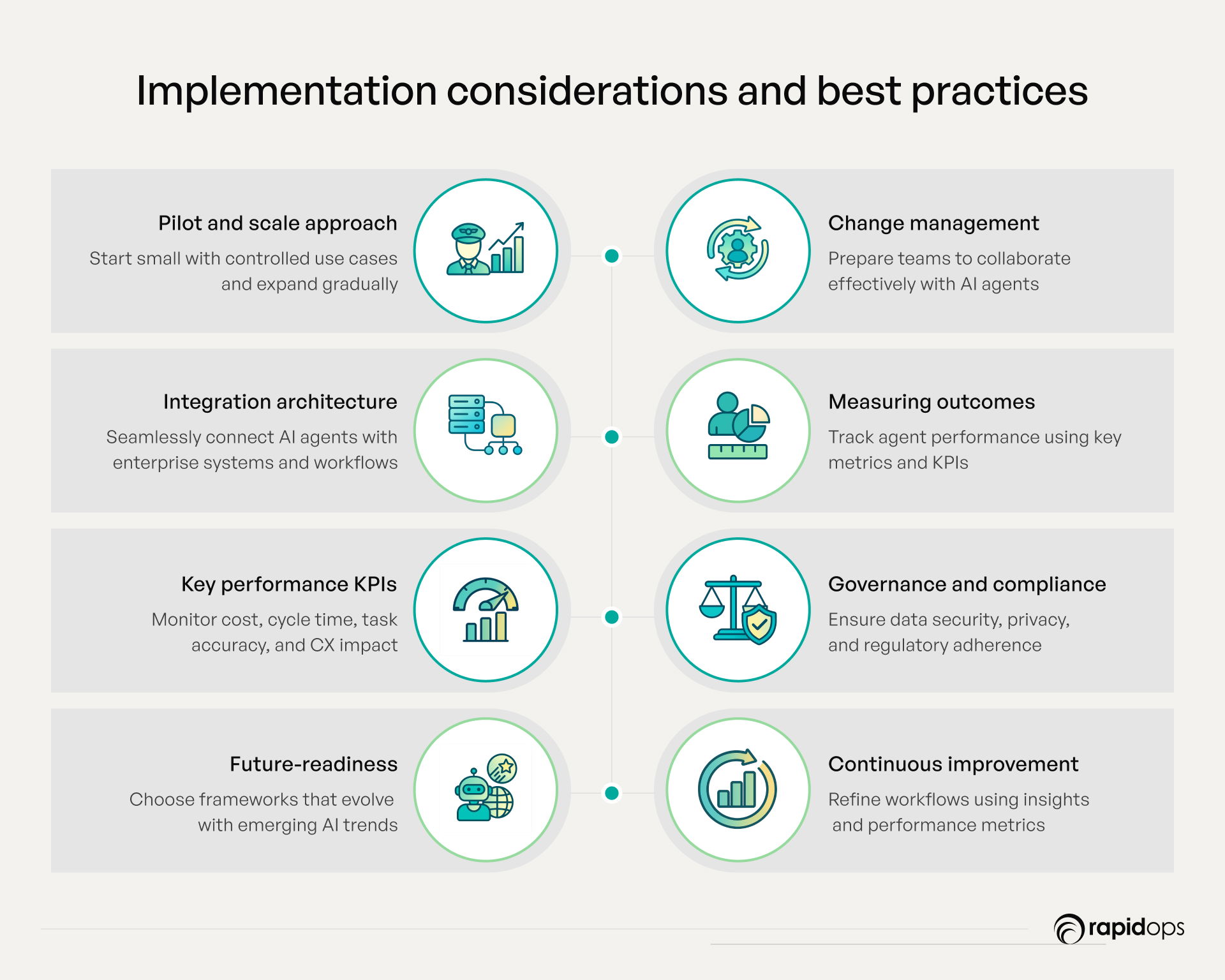
1. Pilot and scale approach
Begin with small, controlled use cases to validate framework capabilities and assess operational impact. Pilot projects allow organizations to identify challenges, refine workflows, and build stakeholder confidence before scaling AI agents across departments. This phased approach ensures controlled adoption while accelerating organizational learning and adaptability.
2. Change management
AI agent frameworks transform how teams operate. Preparing employees through structured training, clear communication, and role alignment is critical to drive adoption. Embedding AI literacy and fostering a collaborative mindset ensures human teams and AI agents function effectively as a cohesive system, reducing friction and improving overall performance.
3. Integration architecture
Seamless integration with enterprise systems, data pipelines, and existing workflows is essential. Frameworks must connect with CRMs, ERPs, analytics platforms, and operational databases to leverage data effectively and deliver actionable insights in real time. Thoughtful architecture design minimizes disruption, ensures interoperability, and maximizes operational utility.
4. Measuring outcomes
Establishing clear KPIs provides a tangible view of AI agent impact. Track metrics such as cost reduction, cycle-time improvement, agent autonomy, task accuracy, and customer experience enhancement. Consistent measurement clarifies ROI, informs iterative improvements, and highlights areas for scaling success.
5. Governance and compliance
AI adoption must comply with organizational policies, regulatory mandates, and ethical standards. Ensuring data security, privacy, and regulatory adherence safeguards the enterprise from risk and maintains stakeholder trust. Governance frameworks should define responsibilities, decision-making authority, and oversight processes for AI agent operations.
6. Future-readiness
Select frameworks capable of evolving alongside emerging AI trends and technologies. Flexibility and scalability enable enterprises to incorporate new algorithms, modalities, or integrations without overhauling foundational systems, ensuring long-term relevance, strategic agility, and sustained competitive advantage.
7. Continuous improvement
Leverage metrics, operational feedback, and workflow insights to refine AI agent processes continually. Iterative optimization enhances task accuracy, maximizes agent performance, and drives measurable business outcomes over time, fostering a culture of sustained innovation and learning.
8. Cross-functional collaboration and risk mitigation
Engage IT, operations, and business teams in planning, implementation, and scaling phases. Proactively identifying integration or operational risks, and establishing mitigation strategies, ensures smoother adoption and reduces potential disruptions across departments.
What enterprises can do with an AI agent framework
AI agent frameworks empower enterprises to transform operations from fragmented tasks into intelligent, adaptive workflows that drive measurable strategic impact. By providing a structured foundation, advanced tools, and actionable insights, these frameworks enable organizations to reimagine processes, decision-making, and cross-functional collaboration.
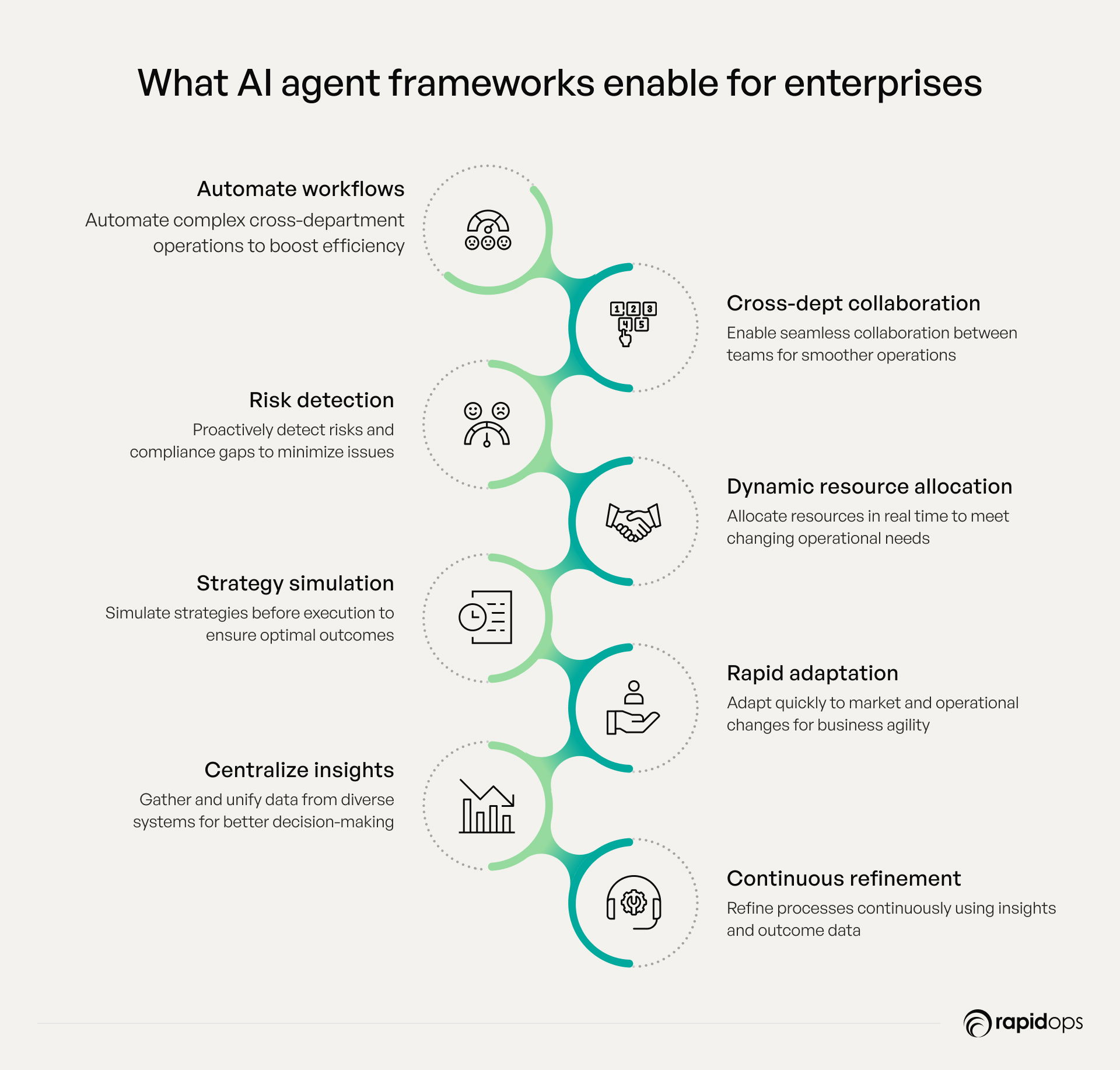
1. Automate complex workflows across operations
AI agents orchestrate end-to-end processes across multiple departments, eliminating manual dependencies and human errors. This streamlines routine tasks, ensures consistent execution, and allows teams to concentrate on higher-value strategic activities.
2. Enable seamless cross-department collaboration
By bridging organizational silos, agents facilitate transparent, real-time information exchange. Teams can coordinate effectively on projects, optimize resource allocation, and maintain alignment with enterprise objectives.
3. Proactively detect risks and compliance gaps
Continuous monitoring of operational, transactional, and regulatory data allows agents to identify anomalies or potential compliance violations early. This proactive risk detection minimizes disruptions and safeguards business continuity.
4. Allocate resources dynamically in real time
Agents track workload, performance, and system capacity, adjusting human, technological, or logistical resources instantly. Enterprises achieve optimal utilization, prevent bottlenecks, and respond fluidly to fluctuating demands.
5. Simulate strategies before live execution
Frameworks enable enterprises to test operational scenarios virtually, model outcomes, and assess new initiatives. Predictive simulations reduce uncertainty, improve decision quality, and mitigate costly operational errors.
6. Adapt quickly to market and operational changes
AI agents continuously analyze trends, operational signals, and customer behavior to recalibrate processes. This agility empowers enterprises to respond swiftly to market shifts, supply chain fluctuations, or evolving business priorities.
7. Streamline collaboration with partners and vendors
Integrating external systems and communication channels allows agents to coordinate seamlessly with suppliers, distributors, and strategic partners, enhancing supply chain efficiency and fostering stronger partnerships.
8. Continuously refine processes based on outcomes
Feedback loops, real-time analytics, and adaptive learning ensure agents iteratively optimize workflows. Enterprises achieve continuous improvement, measurable efficiency gains, and sustainable operational performance.
9. Centralize and extract actionable insights
By unifying data across diverse systems, AI agents generate insights that inform executive decision-making, operational planning, and strategic initiatives. Enterprises gain a holistic perspective, enabling informed, data-driven actions that drive tangible business value.
Making the right choice for long-term impact
Enterprises today face complex operations, fragmented systems, and constant pressure to innovate while staying aligned with strategic priorities. The right AI agent framework brings clarity to this complexity streamlining workflows, unifying insights, and freeing teams to focus on high-impact initiatives that drive growth and innovation.
At Rapidops, we help enterprises evaluate, design, and implement AI agent frameworks that deliver measurable outcomes. By integrating scalable Gen AI solutions and refining processes for smooth adoption, we ensure the framework automates routine tasks, accelerates access to critical insights, removes bottlenecks, and turns insights into actionable results, empowering your teams to achieve the outcomes that truly drive your business forward.
If you’re still unsure which AI agent framework is right for your enterprise, schedule a free consultation with one of our AI experts today to explore our AI agent development services. Our AI experts will assess your business, understand your systems, and help you identify the framework that fits your needs and automate the tasks you care about exactly as you expect, so your teams can deliver results with clarity and confidence.

Rahul Chaudhary
Content Writer
With 5 years of experience in AI, software, and digital transformation, I’m passionate about making complex concepts easy to understand and apply. I create content that speaks to business leaders, offering practical, data-driven solutions that help you tackle real challenges and make informed decisions that drive growth.
What’s Inside
- Understanding AI agent framework
- Key components of AI agent frameworks
- What are the different types of agent frameworks
- How AI agent frameworks make building agents easier
- Key factors in choosing the right AI agent framework
- Comparing AI agent frameworks: Open-source, enterprise-ready and custom-built
- Aligning framework choice with enterprise priorities
- Implementation considerations and best practices
- What enterprises can do with an AI agent framework
- Making the right choice for long-term impact

Let’s build the next big thing!
Share your ideas and vision with us to explore your digital opportunities
Similar Stories
- AI
- 4 Mins
- September 2022

- AI
- 9 Mins
- January 2023


Receive articles like this in your mailbox
Sign up to get weekly insights & inspiration in your inbox.

